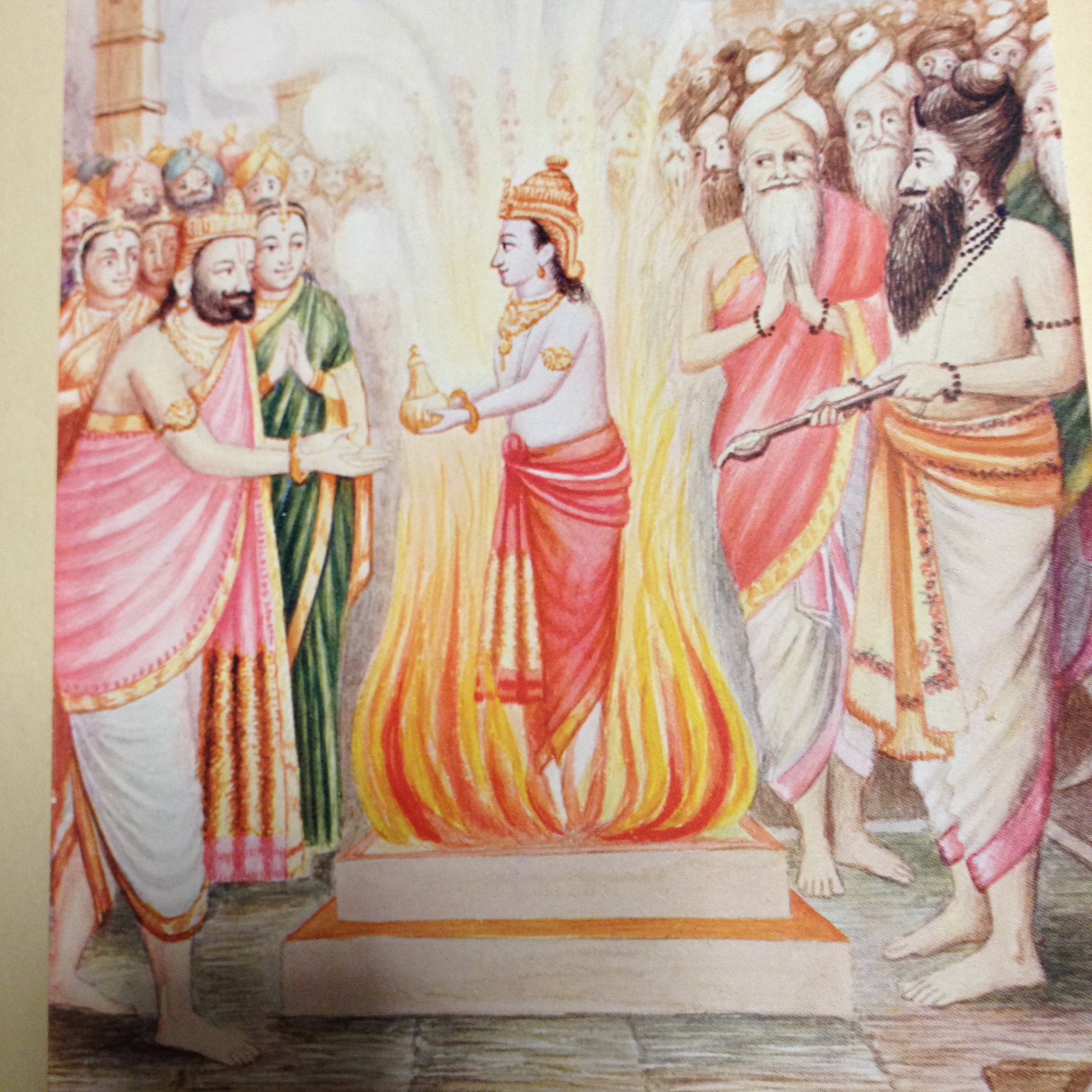Putrakameshti on:
[Wikipedia]
[Google]
[Amazon]
 Putrakameshti () is a special
Putrakameshti () is a special
''Guide to Putrakameshti Homam''
Yajna {{Hindu-myth-stub
 Putrakameshti () is a special
Putrakameshti () is a special yajna
Yajna ( sa, यज्ञ, yajña, translit-std=IAST, sacrifice, devotion, worship, offering) refers in Hinduism to any ritual done in front of a sacred fire, often with mantras.SG Nigal (1986), Axiological Approach to the Vedas, Northern Book ...
performed in Hinduism
Hinduism () is an Indian religion or '' dharma'', a religious and universal order or way of life by which followers abide. As a religion, it is the world's third-largest, with over 1.2–1.35 billion followers, or 15–16% of the global p ...
for the sake of bearing children. It is classified under a series of rituals called the kamya-karma.
Literature
In the ancient Indian epicRamayana
The ''Rāmāyana'' (; sa, रामायणम्, ) is a Sanskrit literature, Sanskrit Indian epic poetry, epic composed over a period of nearly a millennium, with scholars' estimates for the earliest stage of the text ranging from the 8th ...
, upon the recommendation of Sage Vashishta
Vasishtha ( sa, वसिष्ठ, IAST: ') is one of the oldest and most revered Vedic rishis or sages, and one of the Saptarishis (seven great Rishis). Vashistha is credited as the chief author of Mandala 7 of the ''Rigveda''. Vashishtha an ...
, King Dasharatha
Dasharatha (Sanskrit: दशरथ, IAST: Daśaratha; born Nemi) was the king of the Kosala kingdom and a scion of the Suryavamsha dynasty in Hinduism. He ruled from this capital at Ayodhya. Dasharatha was the son of Aja and Indumati. He ha ...
of Ayodhya performed the Putrakameshti Yajna
Yajna ( sa, यज्ञ, yajña, translit-std=IAST, sacrifice, devotion, worship, offering) refers in Hinduism to any ritual done in front of a sacred fire, often with mantras.SG Nigal (1986), Axiological Approach to the Vedas, Northern Book ...
under the supervision of Rishyashringa
Rishyasringa ( sa, ऋष्यशृङ्ग; ; Pali: Isisiṅga) is a Rishi mentioned in Indian (Hindu
and Buddhist) scriptures from the late first millennium BCE. According to the Hindu epics ''Ramayana'' and ''Mahabharata'', he was a boy ...
, an expert in Yajurveda
The ''Yajurveda'' ( sa, यजुर्वेद, ', from ' meaning "worship", and ''veda'' meaning "knowledge") is the Veda primarily of prose mantras for worship rituals.Michael Witzel (2003), "Vedas and Upaniṣads", in ''The Blackwell C ...
, which has the guidelines for this yajna. After its successful completion, the god of fire, Agni
Agni (English: , sa, अग्नि, translit=Agni) is a Sanskrit word meaning fire and connotes the Vedic fire deity of Hinduism. He is also the guardian deity of the southeast direction and is typically found in southeast corners of Hindu ...
, appeared and gave a bowl of payasam
Kheer, also known as payasam, is a sweet dish and a type of wet pudding popular in the Indian subcontinent, usually made by boiling milk, sugar or jaggery, and rice, although rice may be substituted with one of the following: daals, bulgur whe ...
to the King of Ayodhya, which was provided to his three queens in order to promulgate his sons Rama
Rama (; ), Ram, Raman or Ramar, also known as Ramachandra (; , ), is a major deity in Hinduism. He is the seventh and one of the most popular '' avatars'' of Vishnu. In Rama-centric traditions of Hinduism, he is considered the Supreme Bein ...
, Lakshmana
Lakshmana ( sa, लक्ष्मण, lit=the fortunate one, translit=Lakṣmaṇa), also spelled as Laxmana, is the younger brother of Rama and his loyalist in the Hindu epic ''Ramayana''. He bears the epithets of Saumitra () and Ramanuja (). ...
, Bharata, and Shatrughna
''Shatrughna'' ( sa, text=शत्रुघ्न, translit=śatrughna, lit=killer of enemies) is a prince of Ayodhya, King of Madhupura and Vidisha, and a brother of Prince Rama in the Hindu epic ''Ramayana''. He is also known as ''Ripudaman' ...
.
Reference
External links
''Guide to Putrakameshti Homam''
Yajna {{Hindu-myth-stub